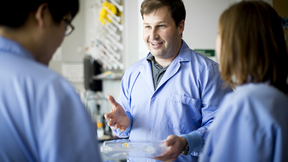Back
Physical and Life Sciences
LLNL's neurotech innovation featured at DARPA's 60th Anniversary Symposium
The Defense Advanced Research Projects Agency (DARPA) held its 60th Anniversary Symposium in Maryland recently, at which an exhibit for the Systems-Based Neurotechnology for Emerging Therapies (SUBNETS) program featured the flexible neural multielectrode arrays developed by Lawrence Livermore National Laboratory (LLNL). The symposium, held to celebrate DARPA’s innovative…
More than a facelift: Lawrence Livermore's radiochemistry labs receive extensive upgrades
Lawrence Livermore National Laboratory (LLNL) continuously upgrades facilities and equipment on the main campus. Infrastructure investments help ensure that scientists, engineers and support staff carry out LLNL’s mission safely and effectively. Building 151 is the latest site of extensive renovations. Construction recently finished in four laboratory spaces, combining two…
Clark wins Davidson Award for Plasma Physics
Daniel Clark, leader of NIF’s Capsule Modeling Working Group within LLNL’s Inertial Confinement Fusion (ICF) Program, has been named the winner of the 2018 Ronald C. Davidson Award for Plasma Physics. The annual award is presented by AIP (American Institute of Physics) Publishing, in collaboration with the American Physical Society (APS) Division of Plasma Physics, to…
The future of carbon storage in forests
Lawrence Livermore National Laboratory (LLNL) researchers and collaborators are looking to the future when it comes to carbon uptake in the forest ecosystem. Soil plays a major role in a healthy climate system. As the largest repository of carbon on land, soil can directly affect the concentration of carbon dioxide in the atmosphere. When more nitrogen is concentrated in…
LLNL-Norway collaboration seeks improved predictive models for cancer outcomes
A group of researchers from Lawrence Livermore National Laboratory recently visited the Cancer Registry of Norway (CRN) in Oslo to discuss the progress of ongoing collaborations between the two institutions aimed at applying big data analytics to predicting cancer risk and mortality. The U.S.-Norwegian partnership began with a project headed by LLNL researcher Ghaleb…
Models show natural swings in the Earth's climate contribute to Arctic sea ice loss
Arctic sea ice loss in the last 37 year is not due to humans alone. New research by a Lawrence Livermore National Laboratory (LLNL) scientist and collaborators show that Arctic sea ice loss is enhanced by natural climate fluctuations such as El Niños and La Niñas. With manmade greenhouse gases on top of the natural climate variability, the decrease in sea ice is even more…
Research team achieves record performance for 3D-printed graphene aerogel supercapacitors
Researchers at Lawrence Livermore National Laboratory (LLNL) and the University of California, Santa Cruz (UCSC) have created 3D-printed supercapacitor electrodes capable of achieving record-breaking performance and overcoming conventional tradeoffs for supercapacitors in the process. In a paper published Oct. 18 by the online journal Joule, the joint research team…
Center Delivers New HED Science Courses
As part of efforts to expand educational opportunities in High Energy Density (HED) science, LLNL’s HED Science Center delivered an 11-week course regarding Extreme Physics for students from the University of California (UC) San Diego. Jeff Colvin, a physicist at LLNL and co-author of the textbook Extreme Physics, taught the class, which took place during Fall 2018…
Don't rule out severe global climate change yet
A key metric of global warming is the Earth’s "equilibrium climate sensitivity" (ECS), which represents the global surface warming that will accompany a doubling of atmospheric carbon dioxide. For nearly four decades, ECS was thought to be somewhere between 2.7 degrees Fahrenheit (F) and 8.1 degrees F, but a more precise estimate has eluded climate scientists. That was…
Oh what a mysterious web they weave
Spider silk is one of the strongest and most complex fibers in the world, but also remains one of nature’s mysteries. Lawrence Livermore National Laboratory (LLNL) researcher John Roehling and collaborators discovered that silk proteins inside spider glands are assembled in nanostructures and lend clues to how the silk is actually produced. The findings could be used to…
DOE looks to Jupiter for high-intensity research
The Department of Energy deemed Lawrence Livermore National Laboratory (LLNL) as one of nine facilities operating high-intensity, ultrafast lasers. DOE’s Office of Fusion Energy Sciences (FES) within the Office of Science awarded the new research network, called LaserNetUS, $6.8 million over the next two years. LaserNetUS includes the most powerful lasers in the United…
'Zombie' stars return from the dead
Black holes are among the most elusive objects in the universe, but research out of Lawrence Livermore National Labroatory (LLNL) suggests the remnant cores of burned-out stars could be the key to making the first observation of the most elusive class of black holes. The research explored whether a dormant white dwarf star — sometimes referred to as a "zombie" star — could…
Nanocrystals arrange to improve electronics
Lawrence Livermore National Laboratory (LLNL) researchers are working to make better electronic devices by delving into the way nanocrystals are arranged inside of them. Nanocrystals are promising building blocks for new and improved electronic devices, due to their size-tunable properties and ability to integrate into devices at low-cost. While the structure of…
LLNL researchers identify how many cancer cells it takes to initiate metastatic tumors
For the first time, researchers have developed a way to determine how many cancer cells it takes to initiate a tumor in another part of the body. The findings, made by a team of Lawrence Livermore National Laboratory (LLNL) scientists, are published in the journal, Scientific Reports. "We think this is an exciting area of research," said LLNL biologist Nicholas Hum, the…
Big results come from small instrument
A new kid is coming to town in the form of an ultra-sensitive, laser-based, carbon-14 spectrometer that will be able to measure samples as small as one microgram of carbon. LLNL engineer Daniel McCartt has built laser-based detection methods for rare isotopes to supplement the Lab’s accelerator mass spectroscopy (AMS) detection capabilities. The new laser-based, rare…
Lab researchers named optical society fellows
Lawrence Livermore National Laboratory (LLNL) researchers Jay Dawson and Tayyab Suratwala have been named Fellows by The Optical Society of America (OSA), a distinction awarded to OSA members for their significant contributions to the advancement of optics and photonics. Dawson was cited for "leadership, innovations and contributions to the understanding of fiber laser…
Four Lawrence Livermore researchers named 2018 fellows of the American Physical Society
Four Lawrence Livermore National Laboratory (LLNL) scientists have been selected as 2018 fellows of the American Physical Society (APS). The new fellows represent a selection of physics expertise, ranging from computational physics to shock compression of condensed matter and instrument and measurement science. APS fellowships are awarded after extensive review and are…
New understanding of the solidification of high-pressure ice found in 'ocean world' planets
A team of theorists from Lawrence Livermore National Laboratory (LLNL) has solved a long-standing puzzle in the nucleation of a high-pressure phase of ice known as ice VII, which is believed to exist near the core of "ocean world" planets recently detected outside of the solar system, and has recently been discovered to exist within the Earth’s mantle. The findings are…
New Consortium Aims to Expand HED Science Education and Research Collaborations
A three-year funding award from NNSA’s Minority Serving Institution Partnership Program enabled LLNL and three academic institutions to form the Consortium for High Energy Density Science, a partnership that aims to expand educational opportunities for students and research collaborations among the participating institutions, which include Florida A&M University,…
First experiments at Europe's new X-ray laser reveal unknown structure of antibiotics killer
DESY-led international collaboration obtains the first scientific results from European XFEL An international collaboration led by Deutsches Elektronen-Synchrotron (DESY) and consisting of more than 100 researchers, including three Lawrence Livermore National Laboratory (LLNL) scientists, has announced the results of the first scientific experiments at Europe's new X-ray…

























